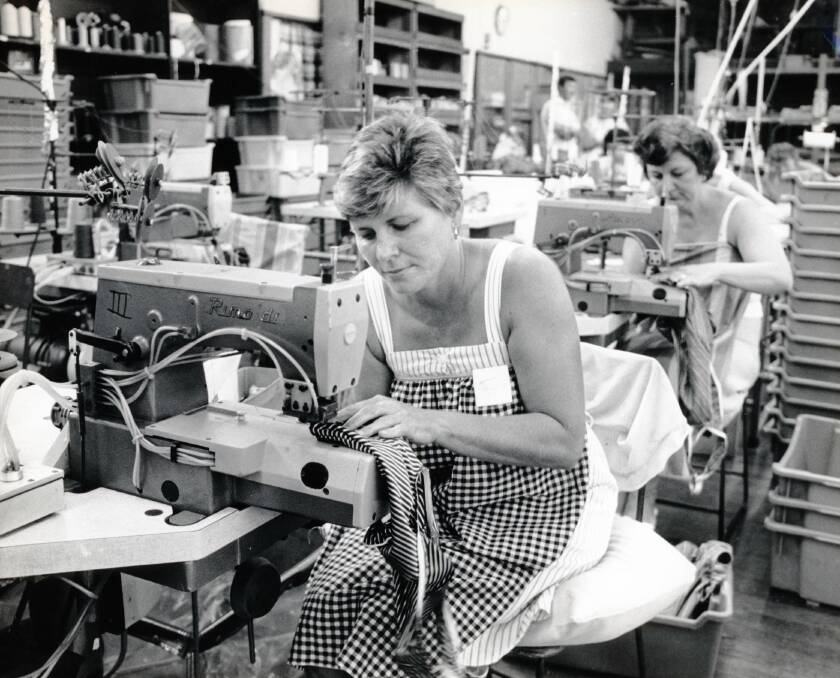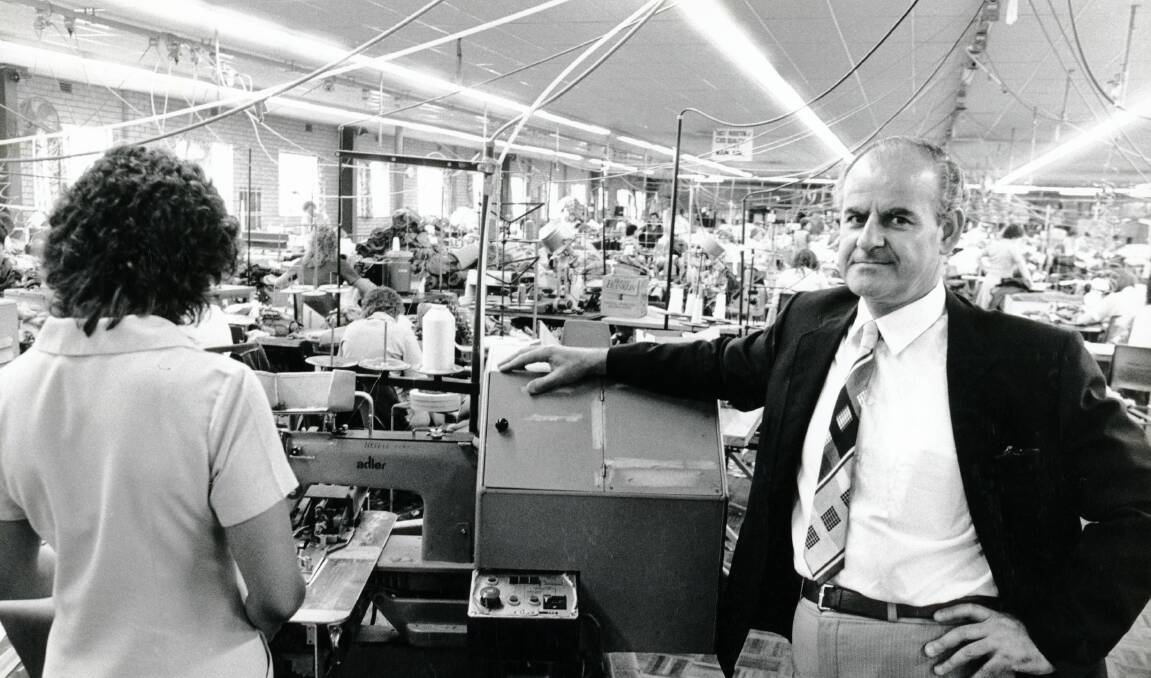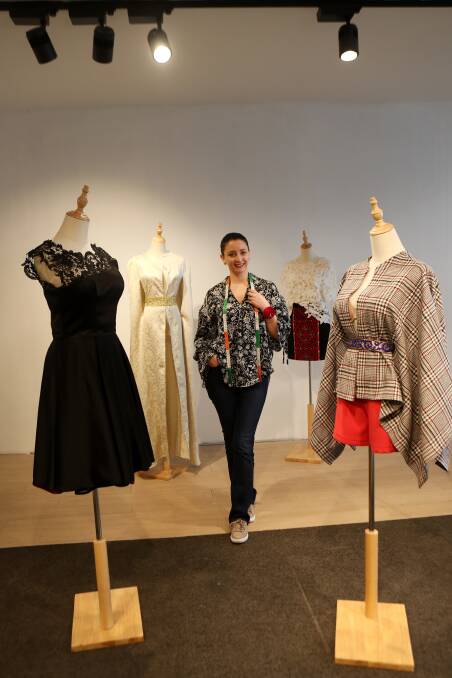Industrial sewing machines may have come to a halt nearly a decade ago, but one woman has plans to resurrect garment manufacturing in the Illawarra.
A fashion designer with a conscience wants to revive garment manufacturing in the Illawarra whilst empowering women in various ways.
Subscribe now for unlimited access.
$0/
(min cost $0)
or signup to continue reading
Jordanian migrant Gina Barjeel, 28, uses sustainable fabrics to create made-to-order fashion, which minimises waste, along with employing women from refugee backgrounds.
Her designs draw on different cultures of the world with each piece made with the purpose to uplift its owner and give them confidence.
Mrs Barjeel first fell in love with fashion at a young age, watching her aunt cut and create.
"I used to take fabrics from my aunt - she was a tailor, a dress maker for 40 years in Jordan," she said.
"I used to take the waste [off-cuts] of the garments she was making and make dresses for my Barbies.
"I would go and look at her sewing and doing the patterns on the fabric and it all started opening my eyes, like 'I want to do that thing'."
Mrs Barjeel followed her husband to Australia about 18 months ago but struggled to find work in the fashion industry.
After months spent searching she decided to launch her own self-titled label in December - a label with a purpose.
"We have the idea of reviving the garment manufacturing in the Illawarra, because it used to be known from the '40s til the '70s for big garment manufacturing in Australia," Mrs Barjeel said.
"The most important thing is Australia is my home now, and we need to support the Australian economy more than anything else."
During the 20th century everything from raincoats to sportswear, Dunlop Volleys, children's wear, army uniforms and underwear were constructed from Helensburgh through to Dapto.

Large factories were enticed to move into the region after World War II with government incentives, in a bid to overcome the problem of high unemployment among women whose husbands were working with steel.
This was especially the case for migrant families in the area as hundreds of thousands of migrants were welcomed into the country post-war to help expand the economy.
In Wollongong, the population increased from 63,000 in 1947 to 171,000 in 1976 - with many women finding work in clothing factories, according to the Textile Clothing and Footwear Union.
The late 1960s represented the industry's peak, with as many as 20 factories operating. But cheap Asian imports, together with lower tariffs, during the 1970s sounded the death knell for most.
Notable companies who produced their wares here included Crystal Clothing Industries (one of the nation's major clothing manufacturing firms at the time), King Gee at Bellambi, Bonds (whom had factories in various locations), Midford/Paramount Clothing at Kembla Grange and Isaacs at Coniston (which took over from the Silknit factory when is closed in the 1960s).
In its heyday, Bonds factories employed 1000 women and operated at three locations in the Illawarra - Warilla, Port Kembla and Unanderra.

Today, migrant families are again being welcomed into the Illawarra community, many fleeing conflict and seeking out the Great Southern Land as refugees.
Mrs Barjeel began helping these women, volunteering at Illawarra Multicultural Services (IMS) to teach them English, as she could speak Arabic.
"I met the women and they started telling me they were looking for jobs and they're still learning the language and how hard and difficult [it was] for them," the designer said.
"I was very, very attached to the women's stories. So we decided to give the idea for the organisation [IMS] ... to start The Women's Fashion Project."
It began with a handful of women who wanted to enhance their skills or build on already existing knowledge of sketching, sewing, cutting and pattern making - skills that make them employable.
Now the project is about to run in its third term, with around 50 women (aged in their 20s through to their 70s) keen to join in.
"We keep upskilling them so they can be in a level they can work in sewing and i'm supporting their employment with other organisations," Mrs Barjeel said.
"Socialising for them is very important because it's a new culture and they're learning still, the language. Not all of them have the opportunity to leave the house."
Mrs Barjeel has begun employing some of the women to help create garments for her bespoke label, something which has helped earn her accreditation with Ethical Clothing Australia.
She called her enterprise "slow fashion" because each piece was made to order to minimise waste. She also uses sustainable, high quality fabrics (like silk and silk-blends) that would "stay with the customer for many years".
In 2010, the Australian Bureau of Statistics estimated we buy an average of 27 kilograms of new textiles every year while about 23 kilograms heads to the tip.

The ABC's War on Waste calculated Australians were currently disposing of 6,000 kilograms of fashion and textile waste every 10 minutes.
"I'm designing all the garments and manufacturing [making] all the garments here and sourcing all the fabrics from Sydney," Mrs Barjeel said.
"Hopefully, in the future we can have our factory here in Wollongong and can ship all the garments to Sydney, NSW and hopefully grow more ... to go international."
Mrs Barjeel is also passionate about paying "fair wages" which is another key reason why she won't look into opening a factory overseas.
She sells her wares for anywhere between $100 to $500, with most of it going back to pay for her workers.
"The brand is for empowering women," the designer said.
"It's even empowering women with upskilling the refugee background women and helping and supporting them, or empowering women from wearing our clothes and designs.
"The designs we are making are for different women ... there's not a specific target of women but it's all about powerful, strong women."
The fledgling label has currently been gifted a prime shop-front in the Crown Street Mall thanks to Renew Wollongong.
Renew aims to bring to life empty commercial spaces by offering temporary opportunities to creatives and artisans trying to build their businesses.
Mrs Barjeel has moved into the old Optus shop near the mall amphitheater, where she can be found designing and creating her clothing.
"I had a couple of clients that they walked in the shop, themselves or their mothers had worked in the factories and were excited about reviving it again," she said. "They felt like it was something they'd like to hear more about."


